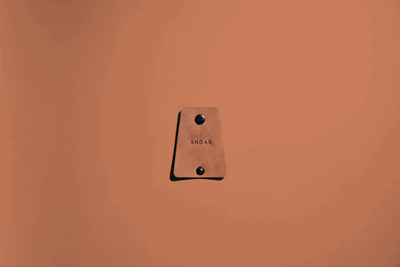The Blog
What Is Sustainable Leather?

In the quest for conscious consumerism, 'what is sustainable leather?' emerges as a crucial inquiry.
Sustainable leather embodies a commitment to environmentally-friendly practices with tanning and manufacturing processes, minimizing environmental impact while upholding ethical standards.
As experts in premium full-grain leather goods and environmental responsibility, we're here to guide you through the world of renewable leather.
Join us at Andar as we delve into the intricacies of this eco-conscious choice and uncover its myriad benefits for both you and our planet's well-being.
What this article covers:- What Is Sustainable Leather?
- How Is Sustainable Leather Made?
- Is Conventional Leather Sustainable?
- Advancements in Sustainable Leather Manufacturing FAQs
What Is Sustainable Leather?
If you're wondering, ‘What is natural leather?' Sustainable leather is a byproduct of farms that implement environmentally-friendly practices and a clear example of this. This contrasts with conventional leather typically produced in commercial factories.
As per our expertise, this leather is sourced as a secondary product of the meat industry within a natural, renewable supply chain.
While leather itself comes from animals, renewable practices focus on minimizing environmental impact and promoting ethical standards in production.
How Is Sustainable Leather Made?
Sustainable leather is made using a number of pertinent materials and techniques.
Use Of Eco-Friendly Materials
Based on our observations, eco-friendly materials such as plant-based dyes and natural tanning agents are employed to reduce chemical usage.
At Andar, we prioritize the use of organic and natural substances that have minimal environmental impact. For instance, we make use of Saguaro cactus for our mens slim wallets like The Pilot and the Blanc leather iPhone case version of The Aspen.
Adoption Of Renewable Energy
Our investigation demonstrated that utilizing solar, wind, or hydroelectric power decreases the carbon footprint and reliance on non-renewable resources.
Recycling And Waste Reduction
Implementing efficient waste management systems and recycling processes significantly reduces the environmental impact of responsible leather manufacturing.
By reusing by-products and minimizing waste, we and other brands contribute to a more renewable production cycle.
Introduction Of Water-Saving Techniques
Innovative water-saving techniques such as closed-loop systems and water recycling are employed in this context.
These methods significantly reduce water consumption and minimize pollution by treating and recycling water used in the leather tanning process.
Traceability And Transparency
Traceability and transparency in the supply chain is essential for sustainable leather production. This means maintaining meticulous records and providing transparency at every stage of the manufacturing process.
Drawing from our experience, traceability allows companies to monitor environmental practices and ensure ethical sourcing of materials for our full-grain leather manufacturing processes.
Use Of Alternative Leather Materials
A variety of materials such as mushroom leather, pineapple leather (Pinatex), and apple leather can be used, which offer eco-friendly alternatives to traditional leather. These alternatives provide similar durability and quality while minimizing environmental impact.
Through these eco-conscious practices, Andar and other brands strive to create responsibly-sourced leather products that meet high-quality standards while contributing positively to the environment and society.
Is Conventional Leather Sustainable?
Conventional leather, while popular, raises sustainability concerns. This is because it often involves intensive water usage (thousands of liters per year) and chemical treatments, which can contribute to environmental degradation.
Additionally, the leather industry's reliance on animal farming can lead to ethical dilemmas and deforestation. This makes it difficult to assess various leather companies and their production processes, hindering efforts towards eco-consciousness.
As a brand committed to reducing our carbon footprint, we at Andar offer renewable alternatives to our consumers, aligning with our values of ethical production and environmental consciousness.
Advancements In Sustainable Leather Manufacturing FAQs
Is Vegan Leather Better For The Planet Than Real Leather?
Vegan leather is beneficial for the planet in that it eliminates animal agriculture's environmental impact, decreases water usage, and minimizes chemical pollution.
In contrast, sustainable real leather, derived from responsibly sourced hides, still offers a more eco-friendly option when managed with ethical practices.
At Andar, we make use of both vegan leather and natural leather in our leather wallets like The Apollo.
Is Sustainable Leather More Expensive Than Traditionally Produced Leather?
Overall, sustainable leather, particularly related to vegan leather production, is less expensive than traditional leather production.
This is due to its ethical sourcing and eco-friendly practices for a number of reasons:
- Harvesting and producing plant-based leathers is less time-consuming than animal-hide derivatives
- Costs of plant-based leather sheets per square foot are more affordable than that of conventional leather hides
Moreover, the long-term benefits, including durability and reduced environmental impact, make responsible leather production far more attractive ahead of common leather manufacturing.
What Role Do Government Regulations Play In Promoting Sustainable Leather Manufacturing?
Government regulations and policies play a significant role in shaping renewable practices within the leather industry.
For instance, the Environmental Protection Agency (EPA) has made provision under the Resource Conservation and Recovery Act (RCRA) for manufacturers to follow certain procedures related to hazardous waste in the leather industry:
- generating
- storing
- transporting
- treating
- disposing
Are There Any Certifications Or Standards That Indicate Whether Leather Is Sustainably Produced?
The Leather Working Group (LWG) provides certification for environmentally responsible leather manufacturing processes.
Additionally, certifications like the Global Organic Textile Standard (GOTS) and Bluesign ensure compliance with strict environmental and social criteria throughout the production chain.
Conclusion
In exploring ‘What is sustainable leather?', we've uncovered how advancements in manufacturing address environmental challenges while providing ethical, durable products. By prioritizing responsible practices, we're steadily paving the way for a renewable future.
Visit us at Andar now to discover our premium modern leather goods collection, helping you carry what matters so we can make a difference together.
If you want to learn more, why not check out these articles below:
- What Is Cactus Leather
- What Is the Strongest Leather in the World
- What Is Vintage Leather
- What Is Breathable Leather
- What Is Cork Leather
- How Long Does Patent Leather Last
- Best Leather Backpack Purse
- Best Men's Leather Work Bag
- Best Mens Leather Weekend Bag
- Best Leather Fanny Pack
- Best Leather Shoulder Bags
- Best Black Leather Bags
- Best Leather Backpack
- Best Leather Backpacks for Women
- Best Mens Leather Backpacks














